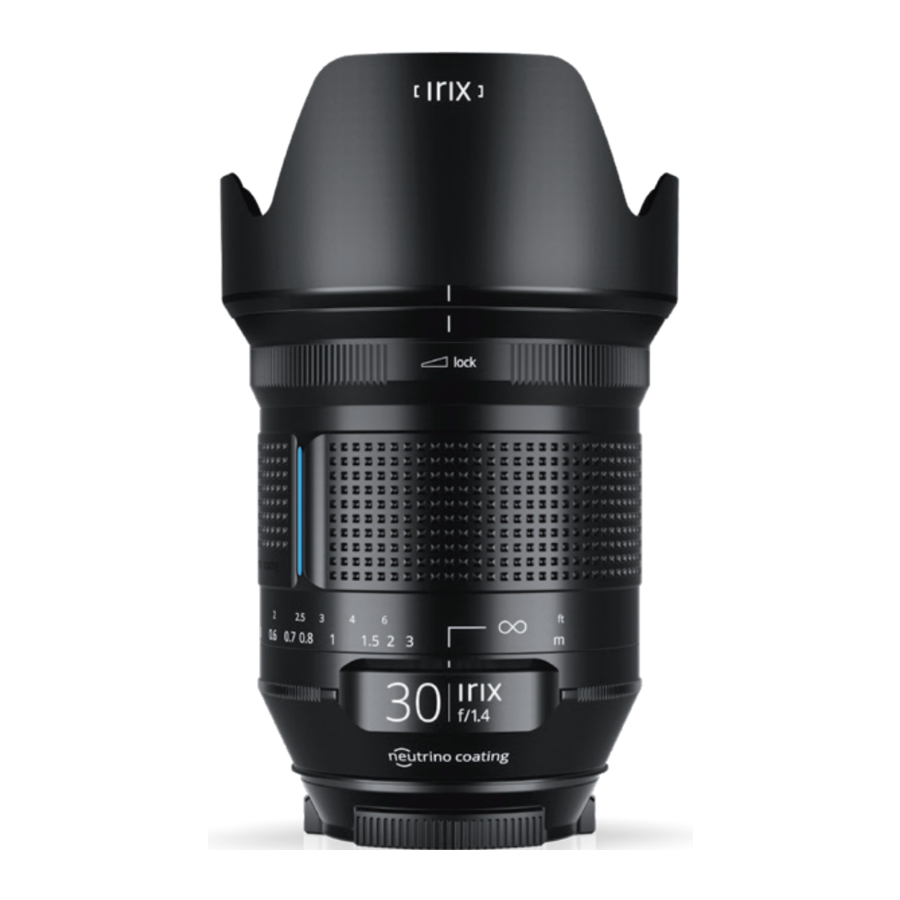Advertisement

OVERVIEW


- Front lens cap
- Front filter thread
- Lens hood
- Focus lock ring
- Focus ring
- Lens mount
- Rear lens cap
FRONT LENS CAP
The front lens cap protects the front lens and should always be put in place whenever the lens is not being used.
FRONT FILTER THREAD
The design of the lens allows the use of 86 x 1,0mm screw-in filters.
Screw the filter on clockwise as viewed from the front lens. Before fully screwing on the filter, make sure the lens does not come into contact with the filter's glass surface, as this may cause damage to both components.
LENS HOOD
The lens hood is used to block light sources to prevent glare and lens flare, which may decrease contrast and cause light reflections in the image.
To attach the lens hood, place it so that the white position marker lines are adjacent to one another. Then turn the hood clockwise, as viewed from the front lens, until you hear a "click". To remove the hood, turn it counterclockwise. During transport, the lens hood can be attached in the reversed position.
FOCUS LOCK RING
The focus lock ring lets you lock the focusing ring into a chosen position.
To lock the focus ring, rotate the focus lock ring left until there is noticeable resistance. To unlock, rotate the focus lock ring all the way to the right.
Attempting to forcibly rotate the focus ring when in its locked position may result in permanent damage to the lens.
FOCUS RING
The lens is not equipped with an autofocus system.
To focus on a given object, look at the image in the viewfinder or on the camera screen and adjust it manually by rotating the focus ring. You can also use the distance scale (in feet or metres) on the lens body to estimate the distance to the chosen object for the photograph.
LENS MOUNT
Mounting the lens to the camera as described in the camera's user manual may differ with various systems.
The marker (dot) on the lens body facilitates mounting the lens onto the camera.
REAR LENS CAP
The rear lens cap protects the lens during transport and should be put in place whenever the lens is not attached to the camera.
APERTURE CONTROL
The aperture of the lens is operated electronically through the camera. Detailed information regarding aperture operation can be found in the camera's user manual and may differ for various systems.
LENS HARDCASE
In order to protect the lens against dust and scratching, it is recommended to keep it stored in a hard case. However, remember that a hard case does not provide protection from water, being dropped, or shock.
TECHNICAL SPECIFICATION
| Image coverage | full frame (43.3 mm) | |
| Focal length | 30 mm | |
| Aperture range (F) | F1.4 ~ 16 | |
| Number of iris blades | 11 (rounded shape) | |
| Minimal focusing distance | 0.34m (13.38") | |
| Focus ring | rotation angle | 140° |
| distance scale | metric and imperial | |
| Aperture ring | rotation angle | None |
| Viewing angle (diagonal) | Full Frame | 72.6° |
| Front filter thread | 86 x 1.0 mm | |
| Weather sealing | 3 rubber o-rings | |
| Markings | laser engraved, UV reactive | |
| Dimensions (L x D) 1 * | Canon EF – mount | 107 x 94 mm |
| Weight 2 * | Canon EF – mount | 863g |
1, 2 – a lens without accessories * for Canon
EF - mount version without lens hood and lens caps
MAINTENANCE
The lenses have anti-reflective coating and are dirt resistant. However, they are not scratchproof. Use only cleaning agents intended for optics. Larger impurities should be removed first with compressed air or with a clean soft brush.
The lens is equipped with a seal to protect the interior from dust and moisture. It is not, however, completely waterproof. Do not submerge it in water or store it for extended periods of time in humid places. To achieve better water-tightness, use of the front protective filter is recommended.
Protect the lens from shock, being dropped and excessive vibration, and do not leave the lens in direct sunlight as a focused light beam may cause a fire. Do not expose the lens to high temperatures. Do not look through the lens at the sun or in its general direction, as that may cause permanent eye damage.
The lens and its attached accessories should be kept away from children and animals, as they contain small elements that constitute a choking hazard.
Unsupervised dismantling of the lens may lead to permanent damage and loss of warranty.
In the case of any faulty operation, it is strongly recommended that you contact the authorized Irix service pointwarranty.
In the case of any faulty operation, it is strongly recommended that you contact the authorized Irix service point
TH Swiss AG
Switzerland
info@irixlens.com
irixlens.com

Documents / Resources
References
Download manual
Here you can download full pdf version of manual, it may contain additional safety instructions, warranty information, FCC rules, etc.
Advertisement

Need help?
Do you have a question about the 30mm f/1.4 and is the answer not in the manual?
Questions and answers